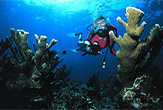Common Ancestor of Fish and Land Animals Found

Scientists have discovered a 405-million-year-old fossilized fish that shares characteristics of modern bony fishes and land vertebrates.
Hundreds of millions of years ago, bony sea creatures of the group Osteichtheyes hit an evolutionary fork in the road. Some animals took the path towards Actinopterygii, a group of modern, ray-finned fish.
The rest evolved into Sacropterygii, the group that includes the ancestors of land vertebrates—coelacanths, lungfishes, and tetrapods.
Scientists pieced together the new fish species, Meemannia eos, from four incomplete skulls unearthed in China.
While the skull's roof looks actinopterygian, the fish possesses a network of pores and canals in the hard surface-tissue, called cosmine, which is characteristic of Sacropterygii.
The discovery provides scientists with both a potential common ancestor for living animals. It also gives insight to the poorly known origin of cosmine, an important protective feature of some fossilized bones, but unknown in living animals.
The find is detailed in the May 4 issue of the journal Nature.
Sign up for the Live Science daily newsletter now
Get the world’s most fascinating discoveries delivered straight to your inbox.









